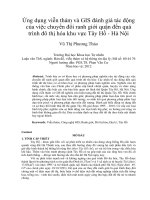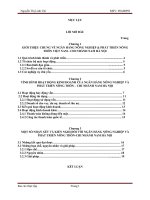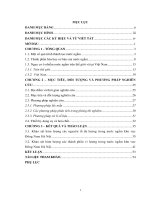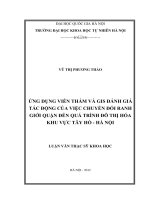BÁO CÁO "Khu đô thị mới Linh Đàm - giải pháp cho mô hình phát triển khu định cư mới có mật độ cao ở khu vực Tây - Nam Hà Nội " ppt
Bạn đang xem bản rút gọn của tài liệu. Xem và tải ngay bản đầy đủ của tài liệu tại đây (1.04 MB, 10 trang )
J. Sci. & Devel., Vol. 10, No. 4: 661- 670
Tạp chí Khoa học và Phát triển 2012 Tập 10, số 4: 661- 670
www.hua.edu.vn
LINH DAM NEW TOWN - SOLUTION FOR THE HIGH-DENSITY DEVELOPMENT
OF NEW SETTLEMENTS IN THE SOUTH-WEST OF HANOI
Quyền Thị Lan Phương
Faculty of Natural Resource and Environment, Hanoi University of Argriculture
Email:
Received dat
e: 12.03.2012 Accepted date: 21.09.2012
ABSTRACT
The study focuses on Linh Dam New Town in the south-west of Hanoi - the biggest and most diverse new
residential area of the city with many projects of New Towns. Hanoi expansion to the south-west will relieve the
overburdened center and re-configure densities. Accordingly, a series of projects of New Town has grown up
with types and sizes and different characteristics to provide new and modern living spaces for residents. Linh Dam
New Town was selected for investigation to discern an overview on the development of high-density and diverse
new residential area in the south-west of Hanoi. The set of criteria used to analyze the case study included Structural
Plan, Uses and Activities, Public Space, Trafic, and Typological Characteristics of Architecture, in order to find out
strengths and weaknesses of the project, as an example for other New Towns
in the south-west of Hanoi.
Keywords: High-density development, New Town, Linh Dam, South-West, urban expansion.
Khu đô thị mới Linh Đàm - giải pháp cho mô hình phát triển khu định cư mới
có mật độ cao ở khu vực Tây - Nam Hà Nội
TÓM TẮT
Nghiên cứu tập trung vào khu đô thị mới Linh Đàm ở khu vực Tây - Nam Hà Nội, vốn được coi là khu vực dân
cư phát triển đa dạng nhất của thành phố với nhiều dự án khu đô thị mới. Hà Nội mở rộng về phía Tây - Nam làm
giảm đi sự quá tải của khu vực trung tâm và góp phần định hình lại mật độ dân cư. Theo đó, hàng loạt dự án khu đô
thị mới phát triển với quy mô và phong cách khác nhau đã cung cấp cho người dâ
n một môi trường sống mới, hiện
đại và tiện nghi. Khu đô thị mới Linh Đàm được chọn làm địa điểm nghiên cứu cho thấy một cái nhìn tổng quát về mô
hình khu đô thị phát triển mật độ cao và đa dạng ở phía Tây - Nam Hà Nội. Những tiêu chuẩn để phân tích đánh giá
khu đô thị mới Linh Đàm bao gồm: Cấu trúc tổng mặt bằng, các loại hình hoạt động và sử dụn
g, không gian công
cộng, giao thông và các đặc điểm về kiến trúc, qua đó thấy được những ưu và nhược điểm của dự án này, như một
thí dụ cho sự phát triển các khu đô thị mới khác ở phía Tây - Nam Hà Nội.
Từ khóa: Đô thị mở rộng, khu đô thị mới, Linh Đàm, mật độ cao, Tây - Nam.
1. INTRODUCTION
High-density development is one of the
major principles upheld by the New Urbanism
(Katz, 1994), since this kind of development
pattern should be able to control aggressive
growth and sprawl. The definition of density
depends on the context in which it is used. In
Higher-density Development - Myth and Fact
(Haughey and Richard, 2005), higher density
simply means new residential and commercial
development at a density that is higher than
what is typically found in the existing
community.
In addition, compact development of a New
Town is a good option in preserving the green
belt, and allowing full utilization of existing
infrastructures. Nevertheless, high-density
development usually brings hazardous impact
on the physical and natural environment, such
661
Linh Dam new town - Solution for the High-density development of New settlements in the South-West of Hanoi
as poor air ventilation created by “wall effect”
development. To examine the development of
Linh Dam New Town and rapid urban
expansion in the south-west of Hanoi, it will be
good to look at the the project idea that can be
used for high-density development of New
Towns in the south-west of Hanoi.
The study focuses on Linh Dam New Town.
The goal is to understand a good community
design concept for the high-density development,
which responds to local cultural and physical
environment in Hanoi and Vietnam.
Firstly, the study reveals some thoughts to
the features and characteristics of urban
expansion underlying urbanization in Hanoi in
general and Hanoi New Towns in particular.
Getting along with the rapid expansion, infill
growth has occurred with high density in the
south-west area of the city.
Secondly, the study gives a critical analysis
of Linh Dam New Town located at the third ring
road of Hanoi in terms of structural plan, uses
and activities, public space, trafic and
typological characteristics of architecture.
Accordingly, the study gives some major
findings about its strengths and weaknesses, as
well as New Town development in the south-
west of Hanoi.
2. METHODOLOGY
Necessary data were collected from MoC,
HUD’s project report, Topos magazine, internet,
including: Hanoi Master plan after expansion,
Hanoi New Towns, Linh Dam project data,
maps and other studies familiar to this study.
Method of selecting case study (Linh Dam):
the study selected Linh Dam because Linh Dam is
considered as a model of New Town in Vietnam. It
is located in a strategic position (on the third ring
road of Hanoi) and considered as one of two new
urban models of Vietnam. Its design concept is a
suitable solution for the high-density development
in the south-west of Hanoi.
Mapping method was used to analyze 5
criteria given in the study results (structural plan,
uses and activities, public space, circulation,
typological characteristics of architecture).
Interviewing was used on three selected
residents in Linh Dam, based on the
questionnaire to find out residents’ response
about their living environment in relation to
housing, transportation, facilities, services,
open spaces, etc.
3. RESULTS AND DISCUSSION
3.1. Urban expansion in Hanoi and New
Towns in the south -west of Hanoi - the
biggest and most diverse new residential
area of the city
According to Shannon (Topos, 2009), the
decision to expand Hanoi westward will, on the
one hand, relieve the overburdened center while,
on the other hand, re-configure densities in what
is already one of the most densely populated rural
areas in the world (the “rural” component of the
Red River Delta average 1000 persons per km2).
Generally, over time, urban Hanoi has
greatly expanded to the west and southwest. The
spatial growth of Hanoi is limited by natural
barriers, such as streams to the northeast and
east, water bodies to the north, and wetland to the
south. Spatially, the expansion of Hanoi stretches
in the obvious directions, and the urbanization
process follows the main transportation axes
connecting the inner city to neighboring areas,
while the administrative boundaries have
expanded in other directions.
The Master plan of Hanoi was approved in
1991 and completed in 1993. In this plan, two
New Towns, Linh Dam and Dinh Cong were
projected. The Master plan in 1993 became
Hanoi’s planning blueprint, guiding its physical
development until today.
Under the Hanoi Capital Construction
Master plan to 2030 and vision to 2050 was
approved on 26th July 2011 (Decision
No.1259/QĐ-TTg), Hanoi will be developed
sustainably, combining cultural and heritage
preservation with socio-economic progress.
Around Hanoi center, The New Towns are
mainly distributed in three parts:
- The North of the Red River: The area
covers a new settlement area in the Northern
662
Quyền Thị Lan Phương
663
part of Hong (Red river) in Dong Anh district.
The area was proposed as a center for
commerce, offices and urban services.
- The East bank the of Red River: The
eastern urban area covers Long Bien and Gia
Lam districts. It was proposed as a development
site for harbour, industrial zones, technical
services, and transport centers.
- The South-West of the Red River
can be divided into three groups: the first group
includes Hoang Mai and Thanh Tri districts; the
second one includes Thanh Xuan, Cau Giay and Tu
Liem quarters, the last one is the central area for
the purpose of resettlement.
Generally, getting along with the rapid
expansion, the east bank of the Red River
exhibited the beginnings of urbanization. The
south-west of the Red River is mostly residential
area, so it has infill growth with higher density
development, as compared to other new areas of
Hanoi (Hanoi center, with the Ancient quarter
in the middle, still has the highest density).
New Towns in the south-west of Hanoi
(including Linh Dam) have been rapidly
developed in many types and forms,
contributing very much in the capital’s
achievements of urban construction in general
and residential area construction in particular.
In addition, it is important to relate the
urban transition with land use change of the
city, with other statistics such as population,
population density, road and housing densities.
Urbanization results in the expansion of
administrative boundaries, stretching in
various directions and leading to changes in
land use, mainly at the periphery. The city’s
periphery has been developing with bigger and
bigger population, together with higher and
higher density of construction. Linh Dam New
Town, located at the third ring road of Hanoi, is
not the exception, so the success of this project
is considered a good solution for the high-
density development of new settlements in the
south-west of Hanoi. Until today, Linh Dam is
considered as the first New Town in Hanoi, as a
“New Town” concept.
Figure 1. The proposed Hanoi construction master plan for 2030 with a vision toward 2050
and location of Linh Dam project (the red point). Westward expansion has been draft by
the Vietnamese Institute of Urban and Rural Planning and will form the basis on which
international consultants will develop the Hanoi expansion plan (Source: MoC, 2009)
Linh Dam new town - Solution for the High-density development of New settlements in the South-West of Hanoi
3.2. Linh Dam New Town - more than 10
years for a model of New Towns
Due to a rapidly growing population in Hanoi,
construction of new houses was growing out of
control by the government. In 1997, the Housing
and Urban Development Corporation, HUD,
formulated a new strategy to control the
spontaneous building and visual complexity
characterizing the cityscape of Hanoi and to
increase the number of flats between 2000 and
2010. Accordingly, HUD introduced the term New
Town for this whole solution strategy and it has
resulted in several new residential areas around
the city, and Linh Dam has been the first one.
Linh Dam was the first project at the
expansion area in the south-west of Hanoi.
Started in 1997 (designed by Arch. Nguyen
Hong Thuc - Hanoi Architectural University),
Linh Dam area which was originally wetland
and agriculture, has became a modern New
Town, combined to the “natural” landscape and
green space, and created a motivation for the
development of the southern gateway of Hanoi
capital. Since 22 - 01 - 2009, the Minister of
Construction has officially signed a decision
that recognized Linh Dam is one of two new
urban models in Vietnam (with Phu My Hung
in Ho Chi Minh City).
Linh Dam located on the third ring road of
Hanoi, in Hoang Mai district, in an area of 184
ha (with 7.32 ha natural lake) and 7 km far
from the city center.
The New Town includes three
components: Bac Linh Dam (North of Linh
Dam), Linh Dam peninsula in the middle and
Linh Dam expansion (South of Linh Dam). The
success of the project has set the stage for a
series of New Towns that have been expanded
nationwide.
Linh Dam project:
- Scale: 184 ha
- Population: 25.000 inhs
- Total floor area: 990.000 m2
- Density of construction: 40 %
- Average height of buildings: 5
- Time of construction: 1997
- Time of completion: 2008
3.2.1. Structural plan
Linh Dam New Town, with Linh Dam
peninsula in the center, can adapt to the
majority of population and tropical climate,
while still respects natural landscape and
ecological system.
Figure 2. Structural diagram of Linh Dam project (Mapping - Quyen Phuong, 2011)
664
Quyền Thị Lan Phương
Figure 3. Linh Dam detailed plan (Source: HUD’s project report)
Linh Dam is planned on a modern urban
planning that is suitable to traditional
architectural style and tropical climate. Among
these, the outstanding point is the area of high-
storey apartments and office buildings in the
center of Linh Dam peninsula, surrounding by
low-storey buildings, parks, open spaces and a
huge water body. Like other urban areas in
Vietnam, Linh Dam has three kinds of
accommodations: apartment building, villa
(surrounding by ground and garden) and street
house. Linh Dam has become a modern and
spacious New Town with more than 4.000 new
accommodations (3.150 apartments), 31,5 ha
green space and an attractive landscape in the
south gateway of the capital city (HUD).
3.2.2. Uses and Activities
Linh Dam project is one of the successful
models of the development of high-rise apartment
buildings. The development of multi-storey
buildings is a modern phenomenon in Vietnam in
1990s, supposedly suited to the trend of
urbanization and modernization. Indeed, the
project has contributed to the city a big amount of
accommodations with high quality.
Public works and facilities are useful for
residents in everyday activities and recreation
such as schools, kindergartens, sport center,
commercial services, markets… The investor,
HUD, has established a service company
responsible for housing management, from
keeping bikes, motors, cars, pump water to
elevator management, garbage collection,
environmental sanitation, security
Hanoi authority has made adjustments for
Linh Dam Master plan in response to the need
of mix uses, more accommodation and more
outstanding architectural positions for Linh
Dam, from the beginning of 2001,. According to
the decision of 2761/QĐ-UBND, the lot of VP6
(located in the penisula) has been changed from
offices to multiple use, including
accommodation, commerce and office. The
decision of 6536/QĐ-UBND has an adjustment
for the two lots in the south-west of Linh Dam
lake with higher density of construction.
665
Linh Dam new town - Solution for the High-density development of New settlements in the South-West of Hanoi
Figure 4. Land use pattern of Linh Dam (Mapping - Quyen Phuong, 2011)
Table 1. Land use planning of Linh Dam (Total area: 1,840,230 m
2
)
Types of use Area (m
2
)
I Linh Dam Penisula 1,600,200
1 Water body 732,638
2 Street network connects to outside 35,268
3 Street network inside 203,710
4 Parking area 10,477
5 Public work 76,606
6 Cultural center 16,805
7 Historical site 12,753
8 Office + Apartment building 78,066
9 Villa 65,244
10 School 9,807
11 Education center 2,184
12 Existing housing area 68,148
13 Kindergarten 4,703
14 Green space 283,791
II North of Linh Dam 140,020
1 Housing area 69,095
2 Green space 10,936
3 Street network connects to outside 5,369
4 Street network inside 23,090
5 Public work 22,510
6 Kindergarten 5,020
III Linh Dam expansion 100,010
1 Housing area 56,914
2 Kindergarten 8,570
3 School 8,469
4 Street network inside 26,057
Source: HUD’s project report
666
Quyền Thị Lan Phương
However, it is not easy to establish New
Towns suitable to the culture, lifestyle and
financial capabilities of the average
Vietnamese. Linh Dam also needs modern
social and technological infrastructure and
living conditions that harmonize with the
natural environment.
Moreover, although Linh Dam has
relatively good facilities, it still does not adapt
to the everincreasing population in the area and
the higher needs of residents. Vu Thi Vinh,
deputy general secretary of the Association of
Cities, said, "Therefore, in many New Towns
finished years ago, such as Linh Dam, there is
still a serious lack of kindergartens, schools,
hospitals and markets". "We don’t have state
schools at all educational levels either," said
Ngo Thi Phuong, who has been living in Linh
Dam for three years. She also said that it was
impossible to find a health care center in her
neighborhood and she had to go to big hospitals
out of the area for health care (fieldwork 21 of
May 2011).
3.2.3. Public spaces
Linh Dam located in a big area with low
building density and large open spaces,
especially in the center of the peninsula
surrounded by the natural lake. This beautiful
water body seems to be the major attraction
point of Linh Dam.
Comparing to other New Towns in Hanoi,
Linh Dam has large open and green spaces
planned at reasonable positions. There are
three local parks with 28 ha in total and 13 m2
green area per person: one in the north, one in
the east and the last one in the west of Linh
Dam area. Among them, the eastern park
(located in the peninsula) is the biggest open
space of Linh Dam. It takes advantages of the
natural lake to create a recreational center in
combination with the multifunctional sport
center, cultural buildings and a religious site
(Lien Dam pagoda). In addition, the lot of CC6
(50.537 m
2
) in the penisula has been
constructed from 2011 with high-rise buildings
and a harmonious network of open green space
and water body. This project is going to be one
of remarkable points for Linh Dam New Town.
More importantly, every three blocks have
an open space for residents as the
constructional density is not as high as other
New Towns in the West of Hanoi.
Although the network of parks and green
spaces has been successful in spatial arangement,
suitable to tropical architectural style in Hanoi,
yet the open spaces inside apartment areas have a
boring design. Quynh Anh, a young resident in
Linh Dam said, the people who are living in
apartments are not interested in the unattractive
open spaces around their blocks, so those spaces
are not really useful for them (fieldwork 10 of
June 2011).
Figure 5. Open space with large water body and tropical architecture
in Linh Dam (Source: HUD’s project report)
667
Linh Dam new town - Solution for the High-density development of New settlements in the South-West of Hanoi
Figure 6. Location of open spaces in high-
rise building area around the main axis
(Nguyen Duy Trinh street)
(Mapping - Quyen Phuong, 2011)
3.2.4. Circulation
Linh Dam has a strategic location that is
easy to go to other parts of the city. The main
entrance is from north Linh Dam, following the
third ring road to approach the main axes.
However, the ring road seems to split the area
into two parts making it difficult for spatial
connection to each other.
The important East - West axes going along
the length of the coronary shape of Linh Dam
Lake, are impressively pointed out by high
blocks which have North - South main facades.
The main axis - Nguyen Duy Trinh street, with
a green boulevard in the middle as a
commercial street, starts at central open space
and ends by the largest park. The central area
of Linh Dam is organized based on the grid
network that is stable, clear for transportation.
The two other residential areas in the north
and the east are more diversely organized but still
coherent, suitable to the shapes of land, convenient
for people to approach public works in the center of
each area and approach the main axes.
In addition, the street network is organized
in such a way that people can easily approach
public transports, although public transports
are still difficult to adapt to people’s needs in
the area. There is only one public parking area
at a reasonable and position - closed to the
main axis. Parking in residential areas is
generally organized in the ground floors of
apartment buildings. As the number of cars gets
higher in the near future, more parking spaces
will be needed.
3.2.5. Typological characteristic of
architecture
The architectural styles in Linh Dam are
relatively harmonious with a combination
between modern and traditional architecture.
High and modern buildings located at the cross
road of the main axis (Nguyen Duy Trinh street)
have created impressive points from different
directions. Recreational areas with low buildings
and diverse architectural styles are suitable to
natural green, water and environment.
The built areas in Linh Dam have become
fancy residential areas, with modern
architecture and fully equipped apartments and
single-family houses. Though the aim is good,
the new areas tend to be separated from their
surroundings and perform more as gated
communities, with empty open spaces and little
spontaneous public life. The likeliness in design
of socialistic neighborhoods is striking.
Stereotype houses accompanied by spacious
streets in attempt to increase living qualities
and dissociate from the crowded old quarters
appear to be the ideology for the New Town.
668
Quyền Thị Lan Phương
669
3.3. Major findings
- The neighborhood unit: it means try to
project the spatial layout of the neighborhood
for the growth of the social community, with a
large presence of public spaces and social
services.
Through the analysis of Linh Dam New
Town, the study points out that New Towns
have been regularly distributed among inner
and suburban districts of Hanoi. This balances
the development of the city to all directions,
exploits reasonably reserve lands and ensures
that public facilities in New Towns can serve for
surrounding residential areas. A significant
land use ratio in this New Town is for
multistory apartments, the rest is for villas,
street houses, public buildings, green areas and
open spaces.
- The hierarchy of the public spaces:
between the streets to preserve the security of
circulation, the pollution and noise; between the
common and green spaces, to balance the need
of privacy and the need of social relationships.
Although Linh Dam project has some
weaknesses in common with many New Towns,
such as compact development, high density of
construction, the lack of necessary facilities,
design of open spaces, etc, its design concept,
through synthesis tools for “architecture design”,
“urban design” and “landscape design”, still
deserve one of the new urban models of Hanoi
and Vietnam, dealing with the high-density
development in the south-west of Hanoi.
The realizations of selected case study show
some basic spatial rules:
- A relationship between built environment
and open spaces could be found in the
residential modern typology: large open and
green spaces between the buildings, the
typology of the residential block.
- A basic functional unit: the relationship
between the living block and the spaces for
social services (kindergartens, schools, social
services for the neighborhood).
3.4. Discussions
With every new projects of New Town, the
planning strategy should progress by looking
Figure 7. Changing types of architecture through main axis (Nguyen Duy Trinh street)
in Linh Dam (Mapping - Quyen Phuong, 2011)
Linh Dam new town - Solution for the High-density development of New settlements in the South-West of Hanoi
back to previous planning projects and learn
from the strengths and weaknesses made there.
The planners and government officials vowed
that the mistakes made in this project would
not be repeated. According to De Klerk (2007),
new urban areas are about “growth and reform,
rational economic planning and rational spatial
planning”. To what extent New Town projects
can learn from Linh Dam? Can they be better
projects after learning from Linh Dam?
4. CONCLUSION
To build completely and stably new urban
in the context of high density development of
south-west Hanoi nowadays, it is necessary to
express basic viewpoints on all related aspects,
including urban expansion, new urban areas
and suitable living environment for new
settlements, or says synchronously from
beginning to end, in other words.
The study has two main findings. Firstly,
the expansion of Hanoi stretches in the obvious
directions and the south-west of Hanoi is the
biggest and most diverse development area.
Secondly, Linh Dam New Town (located in the
south-west of Hanoi) deserves one of the new
urban models, dealing with the high-density
development in the south-west of Hanoi.
By learning from the planning of Linh Dam
New Town, it is expected that a well-developed
suburban planning approach should be adopted
to develop New Towns south-west, so as to
create a socially, environmentally and
economically sustainable living environment for
the present and future generations.
REFERENCES
De Klerk (2007). “New Towns in development policy:
an introduction”, In: D.H. Frieling, ed., Research
on New Towns First International Seminar 2006,
Almere, International New Town Institute,
Almere, p.7-13.
DiGregorio, M, S, J, Leisz, et al. (2003). The Invisible
Urban Transition: Rural Urbanization in the Red
River Delta. Paper presented at "Creating Better
Cities in the 21th Century”, 7th International
Congress of Asian Planning Schools Association,
Hanoi, 12-14 September.
Do, Hau (2004). “Urban Planning in Hanoi City
towards Sustainable Development”. In
International Workshop on Asian Approach
toward Sustainable Urban Regeneration,
September 2004, The University of Tokyo, Japan.
Frieling, D, H. (2006). Research on New Towns. First
International Seminar 2006, Netherland.
Hanoi Association of Urban Planning and
Development (2007). Current Situation
Assessment and Proposals for Planning,
Architecture and Management of New Towns in
Hanoi in Process of Urbanization. Hanoi.
Hanoi’s Communist Party (2006). Program for Hanoi
Urban Construction, Development and
Management in the Period 2006-2010. Hanoi.
Haughey, Richard M (2005). Higher-Density
Development - Myth and Fact. Washington, D.C.
ULI - the Urban Land Institute.
Hà Nội điều chỉnh quy hoạch đất Linh Đàm (2011). 21
of June 2011. />chinh-quy-hoach-dat-linh-dam-06541479.html/
Katz, P. (1994). The New Urbanism: Toward and
Architecture of Community. NewYork: Mcgraw
Hill, 245 pp.
MoC. (2009). Định hướng quy hoạch tổng thể phát
triển đô thị Việt Nam đến năm 2030 và tầm nhìn
đến năm 2050. Ministry of Construction, Hanoi.
Pham, B Viet, Ho, D Duan; Raghavan, V and
Shibayama, M. (2006). “Using Satellite Imagery to
Study Urban Expansion of Hanoi, Vietnam”. In
Proceedings of the International Symposium GIS-
IDEAS 2006, HCMC, Vietnam.
Quyết định số 1259/QĐ-TTG của Thủ tướng chính
phủ: Phê duyệt Quy hoạch chung xây dựng Thủ đô
Hà Nội đến năm
2030 và tầm nhìn đến năm 2050.
/>phu/hethongvanban?class_id=2&_page=1&mode=
detail&document_id=101900/
Shannon, K (2009). “Greater Hanoi - Megacity in the
Making”. In Topos, p.p 98 - 103.
Thanh Thủy (2011). Điều chỉnh quy hoạch khu đô thị
mới Tây Nam hồ Linh Đàm. 21 of January 2011.
/>dieu-chinh-quy-hoach-khu-do-thi-moi-tay-nam-
ho-linh-dam.html/
Tran, Quynh Anh (2005). Khong gian nghi tinh trong
khu DTM Linh Dam. Scientific Research, Hanoi
Architectural University.
Wilson, L. (2009). Observations and suggestions
regarding the proposed Hanoi capital construction
masterplan to 2030 and vision to 2050.
International symposium for the Hanoi capital
construction master plan to 2030 and vision 2050,
Hanoi, April, 21-22.
670









